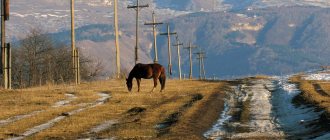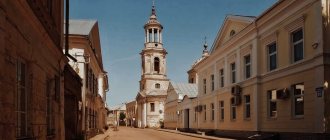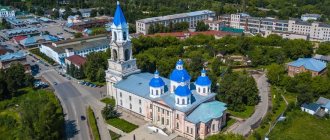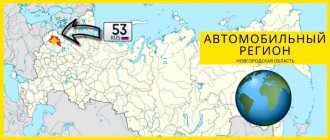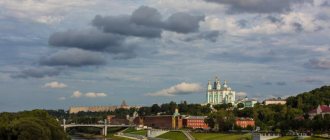| Tver region, Russia | |
| Administrative center: Tver | |
| As of 2013:[1] | |
| # from districts (districts) | 36 |
| # cities and towns (cities) | 23 |
| # from urban-type settlements (urban-type settlements) | 28 |
| # from villagers, rural districts and rural settlements (village councils, rural districts and rural settlements) | 313 |
| As of 2002:[2] | |
| # rural settlements (rural populated areas) | 9,509 |
| Number of non-residential rural settlements (rural settlements without population) | 1,411 |
Administratively, the Tver region is divided into two urban-type settlements administered by the federal government, five cities of regional significance and thirty-six districts.
In terms of population, the largest administrative district is Konakovsky district (87,125 in 2010), the smallest are Molokovsky district (5,235) and Lesnoy district (5,252).[3]
In terms of area, the largest administrative district is Kalininsky District (4,245 square kilometers (1,639 sq mi)), the smallest are Kesovogorsky District (962 square kilometers (371 sq mi)) and Sonkovsky District (970 square kilometers (370 sq mi)).
administrative districts
Administrative districts of the Novgorod region. The numbers indicate the districts: 1 - Andreapolsky, 2 - Bezhetsky, 3 - Belsky, 4 - Bologovsky, 5 - Vesyegonsky, 6 - Vishnevolotsky, 7 - Zharkovsky, 8 - Zapadnodvinsky, 9 - Zubtsovsky, 10 - Kalininsky, 11 - Kalyazinsky. , 12 - Kashinsky, 13 - Kesovogorsky, 14 - Kimrsky, 15 - Konakovsky, 16 - Krasnokholmsky, 17 - Kuvshinovsky, 18 - Lesnoy, 19 - Likhoslavlsky, 20 - Maksatikhinsky, 21 - Molokovsky, 22 - Nelidovsky, 23 - Oleninsky, 24 - Ostashkovsky, 25 - Penovsky, 26 - Rameshkovsky, 27 - Rzhevsky, 28 - Sandovsky, 29 - Selizharovsky, 30 - Sonkovsky, 31 - Spirovsky, 32 - Staritsky, 33 - Torzhoksky, 34 - Toropetsky, 35 - Udomelsky, 36 - Firovsky . .
- Urban-type settlements under federal administration:
Ozerny (Ozerny) - Sunny (Sunny)
:
- Tver (Tver) (administrative center) City districts
: Moskovsky (Moscow)
:
- Andreapolsky (Andreapolsky) Cities
under the jurisdiction of the district: Andreapol (Andreapol)
under the jurisdiction of the district.
- Cities
under the jurisdiction of the district: Bely (Bely)
under the jurisdiction of the district.
- Cities
under the jurisdiction of the district: Bezhetsk (Bezhetsk)
under the county's jurisdiction.
- Cities
under the jurisdiction of the district: Bologoye (Bologoye)
under the jurisdiction of the district:
- Kuzhenkino (Kuzhenkino)
under the jurisdiction of the district.
- Urban-type settlements
under the jurisdiction of the district: Firovo (Firovo)
under the jurisdiction of the district.
- Urban-type settlements
under the jurisdiction of the district: Orsha (Orsha)
under the jurisdiction of the district.
- Cities
under the jurisdiction of the district: Kalyazin (Kalyazin)
under the jurisdiction of the district.
- Cities
under the jurisdiction of the district: Kashin (Kashin)
under the jurisdiction of the district.
- Urban-type settlements
under the jurisdiction of the district: Kesova Gora (Kesova Gora)
under the jurisdiction of the district.
- Urban-type settlements
under the jurisdiction of the district: Bely Gorodok (Bely Gorodok)
under the jurisdiction of the district.
- Cities
under the jurisdiction of the district: Konakovo (Konakovo)
under the jurisdiction of the district:
- Isoplit (Isoplit)
under the jurisdiction of the district.
- Cities
under the jurisdiction of the district: Krasny Kholm (Red Hill)
under the jurisdiction of the district.
- Cities
under the jurisdiction of the district: Kuvshinovo (Kuvshinovo)
under the jurisdiction of the district.
- with 4 villagers
under the jurisdiction of the district.
- Cities
under the jurisdiction of the district: Likhoslavl (Likhoslavl)
under the jurisdiction of the district:
- Kalashnikovo (Kalashnikovo)
under the jurisdiction of the district.
- Urban-type settlements
under the jurisdiction of the district: Maksatikha (Maksatikha)
under the jurisdiction of the district.
- Urban-type settlements
under the jurisdiction of the district: Molokovo (Molokovo)
under the jurisdiction of the district.
- Cities
under the jurisdiction of the district: Nelidovo (Nelidovo)
under the jurisdiction of the district.
- Urban-type settlements
under the jurisdiction of the district: Olenino (Olenino)
under the jurisdiction of the district.
- Cities
under the jurisdiction of the district: Ostashkov (Ostashkov)
under the jurisdiction of the district.
- Urban settlements
under the jurisdiction of the district: Peno (Peno)
under the jurisdiction of the district.
- Urban-type settlements
under the jurisdiction of the district: Rameshki (Rameshki)
under the jurisdiction of the district.
- with 8 villagers
under the jurisdiction of the district.
- Urban-type settlements
under the jurisdiction of the district: Sandovo (Sandovo)
under the jurisdiction of the district.
- Urban-type settlements
under the jurisdiction of the district: Selizharovo (Selizharovo)
under the jurisdiction of the district.
- Urban-type settlements
under the jurisdiction of the district: Sonkovo (Sonkovo)
under the jurisdiction of the district.
- Urban-type settlements
under the jurisdiction of the district: Spirovo (Spirovo)
under the jurisdiction of the district.
- Cities
under the jurisdiction of the district: Staritsa (Staritsa)
under the jurisdiction of the district.
- Cities
under the jurisdiction of the district: Toropets (Toropets)
under the jurisdiction of the district.
- with 22 villagers
under the jurisdiction of the district.
- Cities
under the jurisdiction of the district: Udomlya (Udomlya)
under the jurisdiction of the district.
- Cities
under the jurisdiction of the district: Vesyegonsk (Vesyegonsk)
under the jurisdiction of the district.
- Urban-type settlements
under the jurisdiction of the district: Krasnomaysky (Krasnomaysky)
under the jurisdiction of the district.
- Cities
under the jurisdiction of the district: Western Dvina (Western Dvina)
under the jurisdiction of the district:
- Staraya Toropa (Old Toropa)
- Urban-type settlements
under the jurisdiction of the district: Zharkovsky (Zharkovsky)
under the jurisdiction of the district.
- Cities
under the jurisdiction of the district: Zubtsov (Zubtsov)
under the jurisdiction of the district.
Municipal structure
The municipal structure of the Tver region, taking into account the latest changes, looks like this:
- 11 urban districts,
- 9 municipal districts,
- 22 municipal districts, 29 urban settlements,
- 165 rural settlements.
On May 5, 2022, Zapadnodvinsky, Penovsky, Sandovsky, Krasnokholmsky, Selizharovsky municipal districts and all urban and rural settlements included in them were abolished and transformed into municipal districts; the number of urban settlements was reduced to 29, rural to 165.
City and municipal districts and municipal districts
Story
Before 1918
December 29 [OPERATING SYSTEMS. December 18], 1708 Tsar Peter the Great issued a decree that established seven provinces.[4][5] No description of provincial boundaries is provided; instead, their territory was defined as the collection of cities and the lands adjacent to those cities. The current territory of the Tver region was divided between the provinces of Ingermanland, which was renamed the St. Petersburg province in 1710, the Moscow province, and the Smolensk province. The governorates were divided into counties and counties into volosts. In 1713, the Smolensk province was abolished and divided between Moscow and the Riga province; in 1726 it was restored. In 1727, the Novgorod province was created, and the territories of the current Tver region, belonging to the province of St. Petersburg, were transferred to the Novgorod and Moscow provinces. It was divided into five regions, and the current territory of the Tver region belonged to two of them - Tver province and Velikiye Luki. The rest of the current territory of the region belonged to the Uglich province of the Moscow province and the Belsky district of the Smolensk province.
In 1775-1776 As a result of the administrative reform, provinces were abolished and governorships were created. The current territory of the Tver region is divided between Tver, Novgorod, Pskov, and Smolensk governorships. In 1796, the governorships were abolished and again transformed into provinces of the same name.
In the 19th century, the area was divided into the following counties,
- Bezhetsky district from Tver province (since 1775 the administrative center in the city of Bezhetsk);
- Kashinsky district of Tver province (since 1775, Kashin);
- Novotorzhsky district of Tver province (since 1775, Torzhok);
- Ostashkovsky district of Tver province (since 1775, Ostashkov);
- Rzhevsky district of the Tver province (since 1775, Rzhev);
- Staritsky district of Tver province (since 1775, Staritsa);
- Tver district of Tver province (since 1775, Tver);
- Vyshnevolotsk district of Tver province (since 1775, Vyshny Volochek);
- Zubtsovsky district of Tver province (since 1775, Zubtsov);
- Kalyazinsky district of Tver province (from 1775 to 1796 and from 1803, Kalyazin)
- Korchevsky district of Tver province (from 1781 to 1796 and from 1803 Korcheva)
- Vesyegonsky district of Tver province (from 1775 to 1796 and from 1803, Vesyegonsk)
- Valdai district of Novgorod province (since 1770, Valdai);
- Toropets district of the Pskov province (since 1777, Toropets);
- Belsky district of Smolensk province (since 1708, Bely);
- Porechsky district of Smolensk province (since 1775 Porechye).
Minor areas also belonged to the Kholmsky district of the Novgorod province, the Velizh district of the Vitebsk province, and to the Myshkinsky district of the Yaroslavl province.
1918—1935
March 10, 1918 Krasnokholmsky district with a center in Krasny Kholm. December 28, 1918 Kimry district with the center of Kimry. On April 25, 1921, Vesyegonsky and Krasnokholmsky districts were transferred to the newly formed Rybinsk province. In 1921, a minor exchange of lands took place between the Tver provinces and the Moscow and Rybinsk provinces. On February 23, 1923, the Rybinsk province was abolished, and the counties were returned to the Tver province.[6]
On May 30, 1922, Zubtsovsky, Kalyazinsky and Korchevsky districts were abolished and merged into Rzhevsky, Kashinsky and Kimry districts, respectively.[6]
On August 1, 1927, the Novgorod and Pskov provinces were abolished, and their districts became part of the newly formed ones. Leningrad Oblast, with its administrative center in Leningrad, which included the north-west of the Russian Federation. The region was divided into 140 districts, which were grouped into nine districts. The territories that currently belong to the Tver region are grouped into Velikiye Luki with the center in Velikiye Luki.[7]
The following districts have been created in the Velikoluksky Okrug: [7] Bologovsky, Idritsky, Ilyinsky, Kholmsky, Kuniinsky, Leninsky, Loknyansky, Nasvinsky, Nevelsky, Novosokolnichesky, Oktyabrsky, Ostashkovsky, Penovsky, Porechevsky, Pustoshkinsky, Rykovsky, Sebezhsky, Sovetsky, Toropetsky, Troitsky, Tsevelsky, Usmynsky, Ust-Dolyssky, Usvyatsky, Velizhsky, and Velikoluksky.
The Bologovsky district was created and included in the Borovichi district of the Leningrad region.
On July 12, 1929, the Moscow and Smolensk provinces were also abolished. Their districts formed a number of administrative units, and the current territory of the Tver region overlapped with two of them. Moscow and Western regions. The Western region had an administrative center in Smolensk. These areas were also divided into districts. Velikoluksky District was transferred from Leningrad to the Western Region; In addition, the Rzhev Okrug, with its center in Rzhev, was founded in the Western Region, and most of its territory later became part of the Tver Region. The following districts were formed in the Rzhevsky district: [8] Belsky, Kamensky, Karmanovsky, Lukovnikovsky, Molodotudsky, Nelidovsky, Oleninsky, Pogorelsky, Rzhevsky, Selizharovsky, Staritsky, Stepurinsky, Sychevsky, Vysokovsky, Eltsovsky, and Zubtsovsky.
In the Moscow region, three districts were formed in the territories that later formed the Tver region. They included the following areas:[6]
- Bezhetsky district: Bezhetsky, Kashinsky, Kesovsky, Krasnokholmsky, Maksatikhinsky, Mikhailovsky, Molokovsky, Sandovsky, Sonkovsky, and Vesyegonsky.
- Kimry district: Goritsky, Kalyazinsky, Kimry, Konstantinovsky, Kuznetsovsky, Leninsky, and Nerlsky.
- Tver district: Likhoslavlsky, Novotorzhsky, Rameshkovsky, Spirovsky, Tolmachevsky, Turginovsky, Tverskoy, Udomelsky, Vyshnevolotsky, Emelyanovsky, Yesenovsky, and Zavidovsky.
On July 23, 1930, the districts were abolished, and the districts began to be directly subordinate to the regions. On November 20, 1931, Tver was renamed Kalininskaya.[6]
After 1935
On January 29, 1935, the Kalinin region was formed on the territory of the Moscow, Western and Leningrad regions. The city of Kalinin became the administrative center of the region.[6]
Initially it included the following areas:
- Из Московской области: Бежецкий, Калининский, Калязинский, Кашинский, КесовогорскийКимрский, Конаковский, Краснохолмский, Лесной, Максатихинский, Молоковский, Нерльский, Новоторжский, Рамешковский, Сандовский, Сонковский, Спировский, Толмачевский, Тургиновский, Удомельский, Весьегонский, Вышневолоцкий, Ясеновичский, Емельяновский и Zavidovsky.
- From the Western region: Kamensky, Kholmsky, Leninsky, Loknyansky, Lukovnikovsky, Nevelsky, Nelidovsky, Novosokolnichesky, Oktyabrsky, Oleninsky, Ostashkovsky, Penovsky, Pustoshkinsky, Rzhevsky, Sebezhsky, Selizharovsky, Staritsky, Toropetsky, Velikoluksky, Zubtsovsky.
- From the Leningrad region: Bezhanitsky, Bologovsky, Novorzhevsky, Opochetsky, and Pushkinsky.
In the period from July 9, 1937 to February 7, 1939, the Karelian National Okrug existed as a territory with a special status in the Kalinin region. It was conceived as Tver Karelian autonomy. The district consisted of Kozlovsky, Likhoslavlsky, Maksatikhinsky, Novokarelsky, and Rameshkovsky districts. Its administrative center was located in the city of Likhoslavl.[6]
March 5, 1935 Velikie Luki, one of the districts adjacent to the borders of the Soviet Union. It included Bezhanitsky, Loknyansky, Nevelsky, Novorzhevsky, Novosokolnichesky, Opochetsky, Pustoshkinsky, Pushkinsky, Sebezhsky and Velikoluksky districts. On May 11, 1937, the district was divided into Velikiye Luki and Opochinsky district. On May 4, 1938, the Velikoluksky District was abolished, and on February 5, 1941, the Opochetsky District was also abolished. The districts were directly subordinate to the region.[6]
During the Second World War from 1941 to 1944, the western part of the regions was occupied by German troops.
On August 22, 1944, Velikolukskaya Oblast was created, and on August 23, 1944, Pskov Oblast was created to administer the territories of the Soviet Union previously occupied by German troops and liberated during World War II. A number of districts were transferred from the Tver region to these two regions,[6]
- Ashevsky, Novorzhevsky and Pushkinsky districts were transferred to the Pskov region;
- Bezhanitsky, Idritsky, Krasnogorodsky, Kudeversky, Kuninsky, Leninsky, Loknyansky, Nevelsky, Nelidovsky, Novosokolnichesky, Oktyabrsky, Opochetsky, Penovsky, Ploskoshsky, Pustoshkinsky, Sebezhsky, Serezhnisky, Toropetsk and Velikoluksky districts were transferred to Velikoluksky region.
- The Kholmsky district was initially transferred to the Novgorod region, but on August 22, 1944 it was transferred to the Velikiye Luki region.
On October 2, 1957, the Velikiye Luki region was abolished. Its territory was divided between the Kalinin and Pskov regions. Belsky, Ilyinsky Leninsky, Nelidovsky, Oktyabrsky, Penovsky, Serezhinsky, Toropetsky and Zharkovsky districts were transferred to the Kalinin region, and all other districts were united into the Pskov region. On July 29, 1958, the Ploskoshsky district was transferred from Pskov to the Kalinin region, which finally established the current borders of the Tver region.[6]
In the mid-1960s, the region underwent an unsuccessful Khrushchev-era administrative reform, when districts were first divided into large agricultural and industrial districts, and a few years later these were abolished, and the region received a district structure somewhat different from the previous reform.
In 1990, the Kalinin region was renamed the Tver region.
Abolished areas
After 1927 (with the exception of the failed reform of 1963-1965), the boundaries between districts sometimes changed, resulting in some of them being abolished. This list includes areas that existed in the current region of the Tver region.[6]
- Bologovo district (administrative center in the village of Bologovo), Leningrad region, Western region, formed in 1927, abolished in 1930, divided into Leninsky and Kholmsky districts;
- Bryusovsky district (Bryusovo settlement) Kalininsky region, formed in 1936, abolished in 1960, divided into Maksatikhinsky and Udomelsky districts;
- Goritsky district (village of Goritsy), Moscow region, Kalinin region, formed in 1929, abolished in 1963, annexed to Rameshkovsky district;
- Ilyinsky district (Ilyino village), Leningrad region, Western region, Kalinin region, Velikoluksk region, Kalinin region, created in 1927, abolished in 1960, merged into Oktyabrsky district;
- Kozlovsky district (Kozlovo village) Kalininsky region, formed in 1937, abolished in 1956, divided into Maksatikhinsky and Spirovsky districts;
- Kushalinsky district (Kushalino village) Kalininsky region, formed in 1935, abolished in 1956, divided into Kalininsky, Goritsky and Rameshkovsky districts;
- Leninsky district (village of Khotilitsy, since 1928 in Andreapol), Leningrad region, Western region, Kalinin region, Velikoluksk region, Kalinin region, formed in 1927, abolished in 1963, merged into Toropetsk district;
- Lukovnikovsky district (village of Lukovnikovo), Moscow region, Kalinin region, formed in 1929, abolished in 1960, divided into Kirovsky, Novotorzhsky, Rzhevsky and Staritsky districts;
- Mednovsky district (Mednoye village) Kalininsky region, formed in 1935, abolished in 1956, divided into Kalininsky and Novotorzhsky districts;
- Molodotudsky district (Molodoy Tud village), Moscow region, formed in 1929, abolished in 1932; restored in 1935 as Chertolinsky district (administrative center in the village of Chertolino), Kalinin region; in 1936, the regional center moved to Molodoy Tud, and the district was renamed Molodotudsky; abolished in 1958, divided into Kirovsky, Oleninsky and Rzhevsky districts;
- Nerlsky district (Nerl village), Moscow region, Kalinin region, formed in 1929, abolished in 1956, annexed to the Kalyazinsky district;
- Oktyabrsky district (the village of Staraya Toropa, later the settlement of Western Dvina), Leningrad region, Western region, Kalinin region, Velikoluksk region, Kalinin region, formed in 1927, abolished in 1963, merged with Nelidovsky district into Zapadnodvinsky district.
- Orsha district (Rozhdestveno village) Kalinin region, formed in 1937, abolished in 1959, divided into Konakovsky, Kalinin and Goritsky districts;
- Ovinishchensky district (Kesma village) Kalininsky region, formed in 1935, abolished in 1956, divided into Krasnokholmsky and Vesyegonsky districts;
- Ploskoshsky district (Ploskosh village), Kalinin region, Velikoluksk region, Pskov region, Kalinin region, formed in 1936, abolished in 1960, merged into Toropetsk district;
- Pogorelsky district (village of Pogoreloe Gorodishche), Moscow region, Kalinin region, formed in 1929, abolished in 1934, recreated in 1935, abolished in 1960, merged into Zubtsovsky district;
- Rozhdestvensky district (village of Rozhdestven) Leningrad region, formed in 1927, abolished in 1931, annexed to the Bologovsky district;
- Serezhinsky district (Bologovo village), Kalininsky region, Velikoluksky region, Kalininsky region, formed in 1936, abolished in 1957, divided into Leninsky and Toropetsk districts;
- Tebleshsky district (Kiverichi village) Kalininsky region, formed in 1935, abolished in 1956, divided into Bezhetsky and Goritsky districts;
- Tolmachevsky district (Tolmachi village), Moscow region, Kalinin region, formed in 1929, in 1935 renamed Novokarelsky, abolished in 1956, divided into Likhoslavl and Spirovsky districts;
- Turginovsky district (Turginovo village), Moscow region, Kalinin region, formed in 1929, abolished in 1963, annexed to the Kalininsky district;
- Uglovsky district (Uglovka station), Leningrad region, formed in 1927, abolished in 1932, divided into Bologovsky, Borovichsky, and Okulovsky districts;
- Vysokovsky district (Vysokoye settlement), Moscow region, Kalinin region, formed in 1929, abolished in 1930, recreated in 1936, abolished in 1963, merged into Staritsky district;
- Emelyanovsky district (Esenovichi village), Moscow region, Kalinin region, formed in 1929, abolished in 1958, divided between Vyshnevolotsky, Novotorzhsky, Kamensky and Firovsky districts;
- Yesenovichsky district (Emelyanovo village), Moscow region Kalininsky region, formed in 1929, abolished in 1956, divided into Kalininsky, Staritsky, Turginovsky and Vysokovsky districts;
- Zavidovsky district (urban settlement Novozavidovsky), Moscow region, Kalinin region, formed in 1929, abolished in 1960, merged into Konakovsky district.
Renamed areas
Some districts were renamed: Tverskoy to Kalininsky, Kuznetsovsky to Konakovsky, Kamensky to Kuvshinovsky, Kirovsky to Selizharovsky; Novotorzhsky to Torzhoksky. Kamensky and Kirovsky districts were not renamed directly, but were abolished and then restored under a different name.
Tver region
coat of arms of the Tver region folk project Great Source
The territory of the region as a whole is characterized by flat terrain, where elevated hilly areas of moraine plains and ridges are combined with extensive undulating water-glacial or flat lacustrine-glacial and alluvial lowlands. In most cases, the surface height in the area does not exceed 200 meters in absolute height. The western part of the region is occupied by the Valdai Upland with heights of 200-300 m or more. The Valdai Upland is adjoined in the south by moraine plains (Belsk Upland). In the southwest is the Western Dvina Lowland with alternating small hilly ridges and outwash plains. The eastern part of the Tver region has a flatter terrain. The Upper Volga Lowland is located in the southeast.
The Tver region is located in the Upper Volga basin and on the watershed of the Baltic and Caspian seas.
The Tver region is rich in natural resources. Colossal peat reserves are concentrated in the region; 60% of the region's territory is occupied by forests. The reservoirs of the Tver region provide more than 70% of the fresh water needs of residents of Moscow, the Moscow region and a number of neighboring regions.
The climate of the Tver region is temperate continental, characterized by transitional features from the continental climate of the eastern regions of the European territory of the country to the more humid climate of the northwestern regions.
On the territory of the Tver region there are predominantly sandy loam (sometimes clayey) soddy-podzolic soils. The large massif of the Orsha swamp (Kalininsky district) is rich in peat-bog soils. The most fertile lands are located in the east of the region (Kashinsky and Kalyazinsky districts).
The Tver region is one of the twenty most forested regions of Russia. 55% of the region's territory is occupied by forests, which are the most important natural, economic potential and the most important stabilizing component of the region's environment.
AREAS OF THE TVER REGION
Area - 2281 km². The surface is predominantly hilly, covered with coniferous and mixed forests. The highest point is 222 meters above sea level. The climate is temperate continental. There are 216 lakes in the region, 40% are forests, 7% are swamps. In the forests of the region there are about 200 species of mammals (brown bear, elk, wild boar, wolf, fox, hare, lynx, marten and others), about 240 species of birds (grouse, black grouse, hazel grouse, owl, cuckoo and others), in the lakes - various types of fish. The main rivers are Msta and Berezaika. The largest lakes are Kaftino (32.4 km²), Pyros (30.9 km²).
Area 2047 km². The main rivers are Mologa and Kesma. History Vesyegonsky district is located in the northeast of the Tver region, bordering the Vologda region. The eastern part of the region is located on the banks of the Rybinsk Reservoir.
Vyshnevolotsky district is located in the northwestern part of the Tver region. It borders: in the north - with the Bologovsky and Udomelsky districts, in the east - with the Maksatikhinsky and Spirovsky districts, in the south - with the Torzhoksky and Kuvshinovsky districts, in the west - with the Firovsky district.
The region is located in the Western Dvina Lowland. The area of the district is 1625 km². It borders with the Western Dvina, Nelidovsky, Belsky districts of the Tver region and the Dukhovshchinsky district of the Smolensk region.
Zapadnodvinsky district is located in the southwest of the Tver region. It borders in the south with Smolensk, in the west with Pskov regions, as well as with Toropetsky, Andreapolsky, Nelidovsky, Zharkovsky districts of Tver region. Since 2006, the district has included 7 settlements, of which 2 are urban, 5 are rural. In total, there are 280 rural settlements. The administrative center is the city of Western Dvina. The area of the district is 2.8 thousand sq. km. The population of the district is 19.0 thousand people.
Area 1874 km². The main rivers are Osuga, Negoch, Prechisto-Kamenka. In the 1920s, the volosts of the Tver province were enlarged: Borkovskaya and Tysyatskaya volosts were formed with their center in the village. Kuvshinovo.
The forest region is located in the north of the Tver region. In the north it borders with the Pestovsky and Moshensky districts of the Novgorod region, in the south with Maksatikhinsky, in the east with Sandovsky, and in the west with Udomelsky districts. The maximum length of the region from east to west is 58 kilometers, from north to south – 48 kilometers.
Archaeological explorations and excavations carried out on the territory of the Penovsky district indicate that this territory was unusually attractive to human groups. » The settlement of the territory began to occur after the Valdai glaciation, which began approximately 60 thousand years ago and ended 10-12 thousand years ago.
The Spirovsky district is located almost in the very center of the Tver region, on the watershed between the basins of the Mologa, Medveditsa and Tvertsa rivers, 80 km from the regional center, 253 from Moscow and 397 km from St. Petersburg. The district borders the Vyshnevolotsky, Udomelsky, Maksatikhinsky, Likhoslavlsky and Torzhoksky districts.
The history of Sonkovo land goes back deeply to the times of Stone Age settlements. The oldest archaeological finds discovered on the right bank of the City River date back to the Mesolithic era and date back to the 7th-5th millennium BC. In the 2nd millennium BC. Tribes of nomads, the Fatyanovo people, came to the territory of the region. They left behind amazing objects of material culture - bone needles and stone hammer axes. For many centuries, the Finno-Ugric Merya tribe lived on Sonkovo land.
Toropetsk district is located in the southwest of the Tver region. The center of the district is the oldest city in the region. It became the capital of the princely city early - in 1167, when Rostislav Mstislavovich Smolensky separated the Toropets volost to his son Mstislav. Toropetsk land with a total area of over 28 thousand square meters. m included the current Toropetsky, Zapadnodvinsky, Andreapolsky, Penovsky, Oleninsky, Nelidovsky districts and significant parts of the Velezhsky, Zharkovsky, Usvyatsky, Kunyinsky, Kholmsky, Ostashkovsky, Selizharovsky, Rzhevsky, Belsky districts of the Tver, Smolensk, Pskov and Novgorod regions (the territory of the current district makes up about 12% of the area of Toropetsk land).
Firovsky district is located in the northwestern part of the Tver region. It borders in the north with the Valdai and Demyansky districts of the Novgorod region, the Bologovsky, Vyshnevolotsky, Kuvshinovsky, Ostashkovsky districts of the Tver region, as well as the lands of the ZATO Ozerny.
Source
Hydro resources
There are over 800 rivers in the region, more than 10 km long, with a total length of about 17,000 km. The main river is the Volga (685 km). Its source is located in the Ostashkovsky district. Also, other rivers of particular importance in the region are: Western Dvina (262 km), Tvertsa (188 km), Medveditsa (269 km), Mologa (280 km) and Mezha (259 km). The watershed of the Caspian and Baltic seas passes through the region. [1]
Lakes
There are 1,769 lakes in the region (1.4% of the territory), including Seliger (259.7 km²), Verkhnevolzhskie lakes, Velikoye, Verestovo, Piros and Shlino. The maximum lake content is in the west and north-west of the region. The deepest lakes in the region (evortional) are Brosno (41.5 m) and Dolosets (41 m).
Reservoirs
Swamps
Swamps occupy about 7% of the total area of the region.
Minerals
Mineral resources discovered and developed in the Tver region are mainly deposits of ancient seas, lakes and swamps, and partly a consequence of the activity of glaciers (clastic rocks).
The region's territory is poor in valuable minerals; the brown coal seams of the Moscow Region coal basin are of industrial importance. The largest deposit is Bolshoye Nelidovskoye, which produced about 21 million tons from 1948 to 1996.
In low-lying areas, thick peat deposits with a total volume of 15.4 billion m³ are widespread. Estimated peat reserves amount to 2051 million tons, which is about 7% of the reserves of the European part of Russia. 43 peat deposits with a total area of about 300 thousand hectares have been developed on an industrial scale; the main exploited reserves are concentrated in five deposits located in the central and southern parts of the region. From 1971 to 1999, more than 44 million tons of fuel peat were developed.
Limestones are common (limestone reserves have been developed near the city of Staritsa for several centuries. Dolomite limestones are common along the banks of the Vazuza, Osush, Tsna rivers (marble-like limestones), there are deposits of fusible and refractory clays and quartz sand, sapropels, numerous underground fresh and mineral water layers, open springs (the most famous is the medicinal table water “Kashinskaya”).
There are reserves of tile, brick, and pottery clay, quartz sand, and there are deposits of coal and rock salt.
Climate
The climate of the region is moderate continental, transitional from the continental one in the east of the European territory of the country to the more humid northwestern regions. The region lies in a zone of climatic conditions comfortable for life and recreation. Average daily temperatures in summer are plus 15-20°C, in winter - minus 5-15°C. The average annual precipitation ranges from 560 to 720 mm, the greatest amount of precipitation falls on the western slopes of the Valdai Hills. Stable snow cover is established in late November - early December, the duration of the period with snow cover is 140-150 days, the thickness is 40-60 cm, with a maximum depth of 80 cm.
Average temperatures in January are from −8 to −16 °C, in July +17…+18 °C. Precipitation is about 600-700 mm per year.
Forest resources
The region is located in the forest zone, in the subzone of the southern taiga, turning into broad-leaved and dark-coniferous forests in the north-west and pine forests in the northern and south-western parts.
Forests occupy 4.5 million hectares (about 2.0 million hectares of coniferous trees), or 53% of the total area of the region. The total wood reserves in the region are 658 million m³. Mature forest reserves are estimated at 147.8 million m³, including resources intended for exploitation - about 100 million m³. The estimated logging area is set at 6.2 million m³/year, the volume of logging is about 34% of the logging area (2003).
Western districts of the Tver region what are these districts
The region's population numbers more than 1 million 300 thousand inhabitants. Of these, every fourth person lives outside of cities.
The capital of the Upper Volga region is Tver. This is one of the oldest cities in Russia. In the 14th and 15th centuries, Tver competed with Moscow for the status of the capital of Russian lands.
The distance from the regional center to Moscow is 167 km, to St. Petersburg – 485 km. The region is crossed by the main railways and highways to Northern and Central Europe.
One of the main wealth of the region is natural resources. More than half of its entire territory is occupied by forest. Its area exceeds 5 million hectares.
There are 1,769 lakes and about 800 rivers in the region. Including the great Russian river Volga (its source is located in the region, as well as the source of the Western Dvina River - Daugava) and Lake Seliger, famous throughout the country. Also in the Tver region there are 9 reservoirs, among them Ivankovskoye, Rybinskoye, Uglichskoye, Vyshnevolotskoye, etc.
Another calling card of the Upper Volga region is underground mineral waters. One of the first resorts in Russia was opened in the city of Andreapol in 1806. Mineral
springs in the city of Kashin in pre-revolutionary times enjoyed the glory of Russian Karlovy Vary. Mineral water of various brands is still produced in the region today.
The water resources of the Tver region are in wide demand. They form one of the main sources of water supply to Moscow and the Moscow region. In general, in the western part of the region on the Valdai Upland, sources of drinking water are being formed for the European part of Russia, Belarus, Ukraine and the Baltic countries.
The basis of the region's economy is industry and agriculture. The industrial complex produces more than a quarter of the gross regional product. The main industries in the region are machine tool, aircraft and mechanical engineering, chemical, pharmaceutical, printing, paper and cardboard production, food and electrical industries.
The agro-industrial complex is the traditional specialization of the Tver region. The region contains about 2.5 million hectares of agricultural land. The region occupies a leading position in Russia in terms of fiber flax area, production and processing of meat products, raising fur-bearing animals and others.
The work of social sectors in the Tver region is based on a strong ramified infrastructure. Medical assistance to the population of the region is provided by 87 medical organizations subordinate to the Ministry of Health of the Tver Region, 250 offices of general practitioners, 10 local hospitals, 27 medical outpatient clinics, 509 medical and obstetric centers and 56 medical assistant stations, which employ about 5 thousand doctors and about 11 thousand person of paramedical personnel.
The education system is represented by 460 kindergartens, 518 schools and their branches, 36 institutions of secondary vocational education. The higher school is formed by leading scientific and educational centers, such as Tver State University, Tver State Technical University, Tver State Agricultural Academy, Tver State Medical University.
The region's sports complex unites 3,611 sports facilities, the one-time capacity of which is 78,387 people per hour.
There are more than 10 thousand historical and cultural monuments in the Tver region. According to this indicator, the region is among the leaders in Russia. 14 cities in the region have the status of “Historic City”. Among them are Tver, Torzhok, Ostashkov, Kashin, Kalyazin, Vesyegonsk, Vyshny Volochek and others.
On the territory of the region there are such well-known complexes as the Imperial Travel Palace in Tver, memorial estates associated with A.S. Pushkin’s stay on Tver land.
The Tver Regional Art Gallery is one of the oldest provincial museums in Russia, which is the largest repository of cultural values of the XIV-XX centuries in the region, numbering almost 18 thousand works of fine art of various genres and trends.
Also in the region there are 5 professional theaters, the regional academic philharmonic, and the Tver State United Museum, which includes 32 institutions.
The region is home to the most ancient Orthodox monasteries, such as the Nilo-Stolobenskaya Hermitage in the Ostashkovsky district, the Borisoglebsky Monastery in Torzhok, and the Holy Dormition Monastery in Staritsa.
Now the region is using its great recreational and tourism potential to develop the economy and create new jobs.
About one and a half million guests visit the Upper Volga region every year.
The main directions of tourism development in the region are water and automobile tourism, pilgrimage and educational tourism, gastronomic tourism, as well as active outdoor recreation.
Federal District:
Central
Economic region:
Central
Code of the subject of the Russian Federation:
69
Timezone:
MSK (UTC+3)
In the Tver region:
The territory of the Tver region is united and is an integral part of the territory of the Russian Federation.
The territory of the Tver region consists of administrative-territorial units, which include territorial units.
The Tver region includes:
cities: Andreapol, Bezhetsk, Bely, Bologoe, Vyshny Volochek, Vesyegonsk, Western Dvina, Zubtsov, Kashin, Kalyazin, Kimry, Konakovo, Red Hill, Kuvshinovo, Likhoslavl, Nelidovo, Ostashkov, Rzhev, Staritsa, Tver, Torzhok, Toropets, Udomlya ;
urban districts: the city of Kimry, the city of Rzhev, the city of Tver, the city of Torzhok, Vyshnevolotsky, Kashinsky, Nelidovsky, Ostashkovsky, Udomelsky;
municipal districts: Andreapolsky, Vesyegonsky, Zapadnodvinsky, Krasnokholmsky, Lesnoy, Likhoslavlsky, Molokovsky, Oleninsky, Penovsky, Rameshkovsky, Sandovsky, Selizharovsky, Spirovsky;
municipal districts: Bezhetsky, Belsky, Bologovsky, Zharkovsky, Zubtsovsky, Kalininsky, Kalyazinsky, Kesovogorsky, Kimrsky, Konakovsky, Kuvshinovsky, Maksatikhinsky, Rzhevsky, Sonkovsky, Staritsky, Torzhoksky, Toropetsky, Firovsky;
closed administrative-territorial entities: “Ozerny”, “Solnechny”;
other administrative-territorial and territorial units.
The administrative center of the Tver region is the city of Tver, the status of which is determined by the Law of the region.”
Source
Tver region
CENTRAL Federal District of Russia. Tver region. Area 84.2 thousand sq. km. Formed on January 29, 1935. The administrative center of the Tver region is the city of Tver
The Tver region is a subject of the Russian Federation, part of the Central Federal District, located in the west of the middle part of the East European Plain.
The Tver region is part of the Central Economic Region. The region has great opportunities for agricultural development, but there is an insufficient rural population. The region's agriculture specializes in dairy and beef cattle breeding and flax growing. Pig and poultry farming are significantly developed. Rye, oats, and fodder crops are being sown; potatoes, vegetables.
Industries: Mechanical engineering, Food, Woodworking, Production of building materials and finishing materials, Glass, Textile and leather and footwear, Chemical, Printing. The region's largest power plants are located. The region is poor in valuable minerals, except peat, ceramic clays and quartz sand.
The Tver region has a favorable transport and geographical position between the two largest cities in Russia.
On November 5, 1775, the Tver governorate was established, transformed in 1796 into the Tver province. On January 14, 1929, the Tver province was abolished, and its territories became part of the Moscow and Western regions. The Kalinin region was formed by a decree of the Presidium of the All-Russian Central Executive Committee of January 29, 1935. On July 17, 1990, by decree of the Presidium of the Supreme Soviet of the RSFSR, the Kalinin region was renamed Tver.
She was awarded the Order of Lenin on December 6, 1966 - for the courage and fortitude shown by workers in the fight against the Nazi invaders during the Great Patriotic War and for the successes achieved in the restoration and development of the national economy.
Notes
| Geography of the subjects of the Russian Federation | |
| Republic | Adygea • Altai • Bashkortostan • Buryatia • Dagestan • Ingushetia • Kabardino-Balkaria • Kalmykia • Karachay-Cherkessia • Karelia • Komi • Mari El • Mordovia • Sakha (Yakutia) • North Ossetia - Alania • Tatarstan • Tyva • Udmurtia • Khakassia • Chechnya • Chuvashia |
| The edges | Altai • Transbaikal • Kamchatka • Krasnodar • Krasnoyarsk • Perm • Primorsky • Stavropol • Khabarovsk |
| Regions | Amur • Arkhangelsk • Astrakhan • Belgorod • Bryansk • Vladimir • Volgograd • Vologda • Voronezh • Ivanovo • Irkutsk • Kaliningrad • Kaluga • Kemerovo • Kirov • Kostroma • Kurgan • Kursk • Leningrad • Lipetsk • Magadan • Moscow • Murmansk • Nizhny Novgorod • Novgorod • Novosibirsk • Omsk • Orenburg • Oryol • Penza • Pskov • Rostov • Ryazan • Samara • Saratov • Sakhalin • Sverdlovsk • Smolensk • Tambov • Tver • Tomsk • Tula • Tyumen • Ulyanovsk • Chelyabinsk • Yaroslavl |
| Federal cities | Moscow, Saint Petersburg |
| Autonomous region | Jewish |
| Autonomous okrugs | Nenets • Khanty-Mansi • Chukotka • Yamalo-Nenets |
